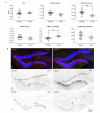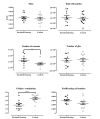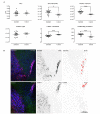Odor Enrichment Increases Hippocampal Neuron Numbers in Mouse
- PMID: 29731675
- PMCID: PMC5934547
- DOI: 10.5607/en.2018.27.2.94
Odor Enrichment Increases Hippocampal Neuron Numbers in Mouse
Abstract
The hippocampus and olfactory bulb incorporate new neurons migrating from neurogenic regions in the brain. Hippocampal atrophy is evident in numerous neurodegenerative disorders, and altered hippocampal neurogenesis is an early pathological event in Alzheimer's disease. We hypothesized that hippocampal neurogenesis is affected by olfactory stimuli through the neural pathway of olfaction-related memory. In this study, we exposed mice to novel pleasant odors for three weeks and then assessed the number of neurons, non-neuronal cells (mainly glia) and proliferating cells in the hippocampus and olfactory bulb, using the isotropic fractionator method. We found that the odor enrichment significantly increased the neuronal cell numbers in the hippocampus, and promoted cell proliferation and neurogenesis in the olfactory bulb. In contrast, the glial cell numbers remained unchanged in both of the regions. Our results suggest that exposure to novel odor stimuli promotes hippocampal neurogenesis and support the idea that enriched environments may delay the onset or slow down the progression of neurodegenerative disorders.
Keywords: Alzheimer's disease; hippocampus; neurodegeneration; neurogenesis; odor stimuli; olfactory bulb.
Figures





Similar articles
-
Early in vivo Effects of the Human Mutant Amyloid-β Protein Precursor (hAβPPSwInd) on the Mouse Olfactory Bulb.J Alzheimers Dis. 2016;49(2):443-57. doi: 10.3233/JAD-150368. J Alzheimers Dis. 2016. PMID: 26484907
-
Enriched odor exposure increases the number of newborn neurons in the adult olfactory bulb and improves odor memory.J Neurosci. 2002 Apr 1;22(7):2679-89. doi: 10.1523/JNEUROSCI.22-07-02679.2002. J Neurosci. 2002. PMID: 11923433 Free PMC article.
-
Research update: neurogenesis in adult brain and neuropsychiatric disorders.Mt Sinai J Med. 2006 Nov;73(7):931-40. Mt Sinai J Med. 2006. PMID: 17195878 Review.
-
New granule cells in the olfactory bulb are associated with high respiratory input in an enriched odor environment.Neurosci Res. 2022 Sep;182:52-59. doi: 10.1016/j.neures.2022.05.007. Epub 2022 May 27. Neurosci Res. 2022. PMID: 35636589
-
Neurogenesis in the adult hippocampus: history, regulation, and prospective roles.Int J Neurosci. 2019 Jun;129(6):598-611. doi: 10.1080/00207454.2018.1545771. Epub 2018 Dec 26. Int J Neurosci. 2019. PMID: 30433866 Review.
Cited by
-
Overnight olfactory enrichment using an odorant diffuser improves memory and modifies the uncinate fasciculus in older adults.Front Neurosci. 2023 Jul 24;17:1200448. doi: 10.3389/fnins.2023.1200448. eCollection 2023. Front Neurosci. 2023. PMID: 37554295 Free PMC article. Review.
-
Distribution of Cadherin in the Parahippocampal Area of Developing Domestic Chicken Embryos.Exp Neurobiol. 2020 Feb 29;29(1):11-26. doi: 10.5607/en.2020.29.1.11. Exp Neurobiol. 2020. PMID: 32122105 Free PMC article.
-
Cognitive and Neurochemical Changes Following Polyphenol-Enriched Diet in Rats.Nutrients. 2020 Dec 27;13(1):59. doi: 10.3390/nu13010059. Nutrients. 2020. PMID: 33375450 Free PMC article.
-
The potential of olfaction loss to induce cognitive impairment and anxiety behavior in mice via the microbiota-gut-brain axis.Front Microbiol. 2025 Jul 2;16:1595742. doi: 10.3389/fmicb.2025.1595742. eCollection 2025. Front Microbiol. 2025. PMID: 40673140 Free PMC article.
-
Olfactory loss is a predisposing factor for depression, while olfactory enrichment is an effective treatment for depression.Front Neurosci. 2022 Sep 28;16:1013363. doi: 10.3389/fnins.2022.1013363. eCollection 2022. Front Neurosci. 2022. PMID: 36248633 Free PMC article.
References
-
- Eriksson PS, Perfilieva E, Björk-Eriksson T, Alborn AM, Nordborg C, Peterson DA, Gage FH. Neurogenesis in the adult human hippocampus. Nat Med. 1998;4:1313–1317. - PubMed
-
- Lepousez G, Nissant A, Lledo PM. Adult neurogenesis and the future of the rejuvenating brain circuits. Neuron. 2015;86:387–401. - PubMed
LinkOut - more resources
Full Text Sources
Other Literature Sources

